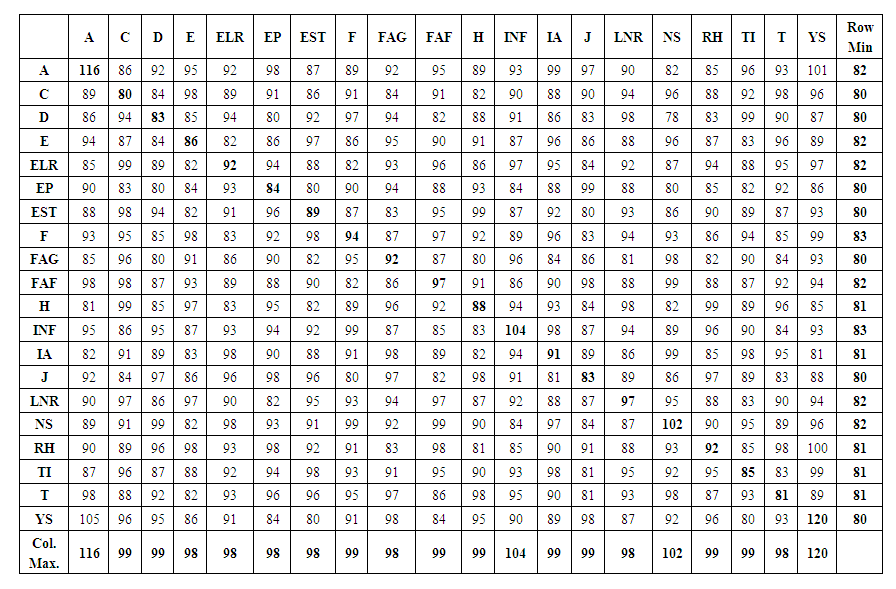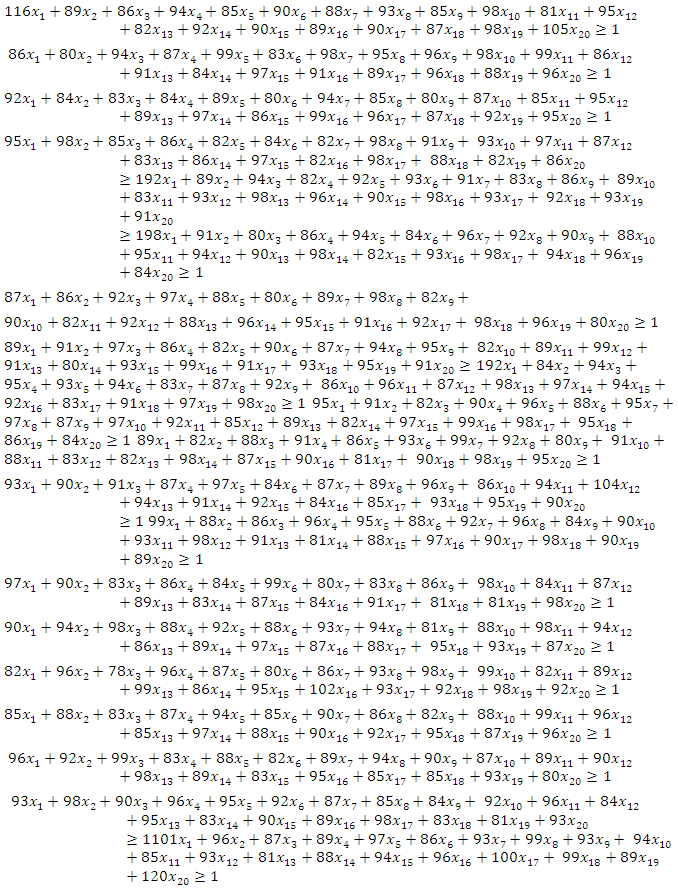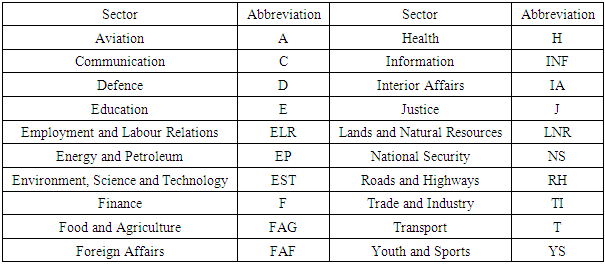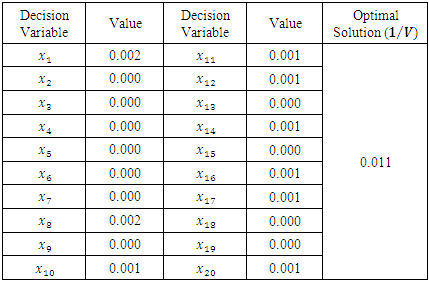-
Paper Information
- Paper Submission
-
Journal Information
- About This Journal
- Editorial Board
- Current Issue
- Archive
- Author Guidelines
- Contact Us
Applied Mathematics
p-ISSN: 2163-1409 e-ISSN: 2163-1425
2020; 10(2): 21-27
doi:10.5923/j.am.20201002.01
Received: Aug. 26, 2020; Accepted: Sep. 22, 2020; Published: Oct. 15, 2020

Analysis of the Performance of Two Political Parties in Ghana Using Game Theory and Linear Programming
Issah Musah, Douglas Kwasi Boah, Baba Seidu
Department of Mathematics, C. K. Tedam University of Technology and Applied Sciences, Navrongo, Ghana
Correspondence to: Douglas Kwasi Boah, Department of Mathematics, C. K. Tedam University of Technology and Applied Sciences, Navrongo, Ghana.
| Email: |  |
Copyright © 2020 The Author(s). Published by Scientific & Academic Publishing.
This work is licensed under the Creative Commons Attribution International License (CC BY).
http://creativecommons.org/licenses/by/4.0/

Conflicts and competitions are part of life. Examples are military battles, advertisement by similar business entities, campaigns by political parties etc. Democracy in Ghana is very vibrant and elections are keenly contested. Only two political parties in Ghana, the National Democratic Congress (NDC) and the New Patriotic Party (NPP) have had the opportunity to be in power since 1992 in spite of the many political parties in the country. The general objective of the study was to analyse the performance of the two dominant or major political parties since 1992 using Game Theory and Linear Programming. Primary data was obtained through a questionnaire that was prepared and administered to two hundred (200) respondents to indicate their patronage for the two political parties as far as twenty (20) selected sectors of governance are concerned. The sectors of governance were regarded as strategies employed by the two political parties to influence citizens to patronize their parties. In conclusion, a payoff matrix of the performance of the two major political parties since 1992 has been successfully constructed using the concept of Game Theory. Also, the values of the game for the two parties associated with the payoff matrix have been successfully obtained using the concept of Linear Programming. Moreover, for the two political parties to become more vibrant and competitive, their optimal strategies have been clearly spelt out. It is recommended that the two political parties should maintain their perceived good performance in the indicated sectors and improve upon their perceived bad performance in the remaining sectors of governance. Also, all political parties should consider game theory when analyzing their political strategies.
Keywords: Performance, Political Parties, Sectors of Governance, Game Theory, Linear Programming, Optimal Strategies
Cite this paper: Issah Musah, Douglas Kwasi Boah, Baba Seidu, Analysis of the Performance of Two Political Parties in Ghana Using Game Theory and Linear Programming, Applied Mathematics, Vol. 10 No. 2, 2020, pp. 21-27. doi: 10.5923/j.am.20201002.01.
Article Outline
1. Introduction
- Conflicts and competitions are part of life. Examples are military battles, campaigns by political parties, advertisement by similar business entities etc. According to Boah et al [1], scientific fashions of this nature formally referred to as game theory can be handled in a well-organized way. Competition is a phenomenon in which a winner is selected from among two or more contestants. Institutions, political parties, states, businesses, sporting activities etc. compete or contest in a way for supremacy. According to Aryee [2], competition in politics is seen when two or more candidates or parties strive for a goal which cannot be shared through an election. Also, the winner gets the seat of the elected office for a predefined period of time after which another election is conducted to determine the next holder of the office. Cadman [3] presented that manifestos normally provide an opportunity to make proposed policies or promises and interventions known to the electorates so as to win their votes. Again, manifestos can provide tangible means for voters to assess the capabilities of parties which aim to solicit as many voters as possible.Democracy is consolidating across Africa. An outstanding feature of democracy is that, the power to rule lies with the people. Democracy in Ghana is very vibrant and elections are keenly contested. Generally, the elections are credible, and almost all voters participate in them. The wining party is always in charge of everything. That party has sole power to appoint staffers at the presidency, ministers, chief executive officers, board members, managers etc. and also award contracts. Only two political parties in Ghana, the National Democratic Congress (NDC) and the New Patriotic Party (NPP) have had the opportunity to be in power since 1992 in spite of the many political parties in the country. The two dominant or major political parties are characterized by their ideologies. The NDC claims to be socially democratic whilst the NPP, liberally democratic. Geographically, the support bases of the two major parties are different. Over the years, the Ashanti Region has been the stronghold of the NPP while that of the NDC have been the Volta and Northern Regions. The swing regions have been the Central Region, Western Region and Accra Metropolis. Leadership’s character (incorruptibility, modesty, honesty etc.), competence and past records are what the two parties use to distinguish themselves. According to Aryee [2], the supporters of the two parties operate like fun clubs or associations. Cadman [3] again presented that, most elections in Ghana are contested based on promised projects, reduction in utility prices, restoration of allowances, payment of accrued salaries and arrears, elimination of some taxes and school fees etc. and that negative policies are scrupulously avoided by administrations. The Electoral Commission of Ghana is mandated to conduct credible elections in Ghana and also streamline the activities of all registered political parties.Due to the competitive nature of politics in Ghana, political parties in the country always have issues to deal with. They are always concerned with how to keep or maintain their existing support base and also win frustrated members of the opposing parties or win floating voters to their parties. Also, every political party in the country is challenged with rolling out policies and strategies that will please electorates so as to lure them to like their parties. Game theory which has an impact on almost every competition can be employed to obtain optimal ways of operation for political parties in the country. When the best or optimal ways are identified, the trust of the political parties will improve and citizens’ satisfaction will be increased. The general objective of the study was to analyse the performance of the two dominant or major political parties since 1992 using Game Theory and Linear Programming. Specifically, the study sought to construct a payoff matrix of the performance of the two political parties using game theory; formulate the payoff matrix as a Linear Programming (LP) problem and solve; and finally determine optimal strategies for the two political parties.
2. Literature Review
- According to Kumar and Reddy [4], game theory is concerned with uncertain decisions comprising two or more opposing and intelligent agents or people whereby each one of them aims to outwit the other opponent(s). It provides a platform which can be used to formulate, analyse and understand distinct strategic or tactical situations. The maiden information about the theory of games was put forward by James Waldegrave in 1713. In his missive, he made available a solution to a two-person card game with mixed strategies. In 1921, Emile Borel made a suggestion about a formal way of handling the theory of games. In 1928, his suggestion was furthered by John Von Neumann in his published paper that served as the bedrock of a two-person zero-sum game. In 1944, Oskar Morgenstern and John Von Neumann made available a book titled ‘The Theory of Games and Economic Behaviour’. That move was believed by many to give rise to the theory of games as an area of learning or research. In 1950s, John Nash, Harold Kuhn, John Harsanyi etc. developed the theory of games intensely. According to Von Stengel [5], John Nash advanced the apparatuses and ideas of theory of games proposing the universal ‘cooperative bargaining and non-cooperative theories’. He brought forth what is nowadays termed the ‘Nash equilibrium’ of a tactical game in 1951 by establishing that every finite game at all times has a stability point, at which every competitor selects moves which are paramount for them being fully aware of the selections or picks of his/her competitors or challengers. The theory of games was expanded hypothetically and used to solve warlike, political and philosophical issues in the 1950s and 1960s. The concept of game theory has since received much attention. A number of papers in the theory and applications of queuing theory have been reported in the literature. Zeng and Fan [6] employed prisoner’s dilemma principle to find the extent of cooperation and competition between operators in Telecommunication Industry in China. In fact, Nash Equilibrium Technique was used by them to find the point of equilibrium of the contest in the market. Reinhardt and Dada [7] applied a game with alliance symmetry to determine ways of splitting saving costs accrued by putting together crucial assets in an unbiased manner. Musa and Sunday [8] used game theory to find the best approaches or tactics for two rival banks using the Maximin-Minimax solution method. The payoffs were obtained to be 60% and 40% for the larger and smaller banks respectively. Kyung-Joon et al [9] explored ways to advance network capability by fine-tuning the transferor intelligence frequency in wireless grids or networks. They presented a non-supportive game-theoretical framework which led to a completely distributed procedure for fine-tuning the transferor intelligence frequency. Andrea et al [10] presented a model to examine multi-person setting where competitors can tactically convey their secretive information to persons who are linked to them in a network for communication. Oziegbe [11] employed game theory to solve commercial decision glitches or problems in not fully developed countries. Nigeria was used as a case study. He employed the maximin-minimax method to obtain the points of stability or equilibrium of the game. Achugamonu et al [12] investigated objective project optimization of MTN and GLOBACOM in advertising their products and other services they render within Nigeria. The Simplex Algorithm and Theory of Duality were the solution methods employed to obtain optimal strategies for the two telecommunication firms. Harrison [13] presented an analytical description of the nature of interaction between fiscal and monetary policy in Nigeria. He used game theory to model and analyse the situation. Adeoye et al [14] employed game theory to determine fruits and vegetables which make the most of aggregate earnings of farmers under dangers taking into consideration distinct features of the farmers. Ayo et al [15] applied game theory to a political party in Nigeria. They used multi-zero-sum model to obtain the winner in presidential primaries of the political party. Rafael et al [16] conducted a study on the quality customer service delivered by mobile telecommunication workers in the marketplace using game theory. They revealed that low-quality consumer service was not efficient and that the inefficiency was as a result of demand-side market failure emanating from incomplete information. Oluyole et al [17] employed game theory to examine a cocoa production supervision organization which gets the most out of farmers’ profits under threats. Boah et al [1] employed game theory to examine the extent of patronage of two Radio Stations in Kumasi, Ghana. They proposed optimal strategies for the two stations to help them receive higher patronage. Yusuf et al [18] applied a two-person zero-sum game to find the extent of competition between ‘Tanners’ and ‘Pomo’ traders in hides selling contest in Nigeria. Kyle [19] used time series regression model and game theory to investigate the prospects of an international shale revolution, its impacts on the Organization of Petroleum Exporting Countries (OPEC) market shares and OPEC responses to the potential of shale developments. Bockova et al [20] presented how game theory can be used as a tool for project management. Gryzl et al [21] presented how game theory can be employed to manage conflict in a construction contract. They examined the best or finest tactic or approach for a general contractor in a situation of conflict with an investor. Stankova et al [22] presented how treatment of cancer can be optimized using game theory. Padarian et al [23] employed game theory to interpret a ‘digital soil mapping model’. According to them, how the model was interpreted is a vital or important stride that can result in generation of fresh ideas to enhance people’s understanding of soils. From the reviewed literature and to the best of our knowledge, application of game theory to politics in the manner presented in this paper appears non-existent. The study was therefore intended to fill that knowledge or research gap.
3. Materials and Methods
- The study mainly used primary data which was collected using a questionnaire prepared and administered to two hundred (200) educated respondents to find their patronage for the two political parties as far as twenty (20) selected sectors of governance are concerned. The sectors of governance were regarded or taken as strategies used by the two political parties to influence citizens to patronize their parties in Ghana. Due to the swing nature (per the electoral history) of the Shama and Assin North constituencies in the Western and Central regions of Ghana respectively, they were chosen purposively for the study. The respondents were sampled purposively by considering their ages and how politically unbiased their environments have been. Specifically, the technique was employed to obtain varied views of citizens in swing regions in the country who have witnessed elections from 1992 to date. Respondents who needed further explanation of the questionnaire were assisted in that direction. The communities selected together with the respective number of respondents (in brackets) were Shama Junction (20), Assorku Essaman/Fawomanye (10), Inchaban (20), Shama or Beposo (20), Supomu Dunkwa (20) and Aboadze/Dwomo (10), all within the Shama Constituency in the Western Region of Ghana and Assin Breku (20), Assin Aworabo (15), Assin Ayitey (15), Assin Aworoso (20), Assin Asibrim (15) and Assin Gold Coast Camp (15), all within the Assin North Constituency in the Central Region of Ghana.In game theory, an opponent is referred to as a player. Each player has a number of choices, finite or infinite called strategies. Different players may be allowed different moves, but each player knows the moves available to the other players. The outcomes or payoffs of a game are summarized as functions of different strategies for each player where if one player wins, another player loses, the game is called a Zero-sum game. Hence, a game with two players, where a gain by one player equals to a loss to the other, is known as Two- person Zero-sum game. In a two-person zero-sum game, it suffices to express the outcomes in terms of payoffs to one player. A pay-off matrix is used to summarize the payoffs to the player whose strategies are given by the rows of the matrix. A two-person constant-sum game is a two-player game in which, for any choice of the players’ strategies, the rewards of the players add up to the same value. Some of the solution procedures/methods usually employed in game theory are Maximin-Minimax Method, Dominance Method, Algebraic Method, Arithmetic Method, Matrix Method, Graphical Method and Linear Programming Method. For a detailed discussion of game theory and its associated solution methods/procedures, the interested reader is referred to Hillier and Lieberman [24], Shama [25] and Taha [26].
4. Results and Discussions
- The twenty (20) purposively selected sectors of governance for the study are as given in Table 1.
|
 | Table 2. Payoff Matrix for the Row Player (NDC) |
 Subject to
Subject to
 | (1) |
 are the probabilities of the row player (NDC) selecting the 20 strategies (sectors) respectively starting from Aviation (A), Communication (C) through to Youth and Sports (YS) and V is the value of the game for the row player (NDC).Management Scientist Version 5 software developed by Anderson et al [27] was used to solve the resulting linear programming model for the row player (NDC). Table 3 gives the optimal solution obtained.
are the probabilities of the row player (NDC) selecting the 20 strategies (sectors) respectively starting from Aviation (A), Communication (C) through to Youth and Sports (YS) and V is the value of the game for the row player (NDC).Management Scientist Version 5 software developed by Anderson et al [27] was used to solve the resulting linear programming model for the row player (NDC). Table 3 gives the optimal solution obtained.
|
 implies that the value of the game, V to the row player (NDC) =
implies that the value of the game, V to the row player (NDC) =  Therefore, the value of the game to the column player (NPP)
Therefore, the value of the game to the column player (NPP)  Based on the above results and analyses, it is very conspicuous that the National Democratic Congress (NDC) are seen to have performed better in four (4) out of the twenty (20) sectors of governance selected for the study namely Aviation (A), Information (INF), National Security (NS) and Youth and Sports (YS) than the New Patriotic Party (NPP) since 1992. On the other hand, the New Patriotic Party (NPP) are seen to have performed better in sixteen (16) out of the twenty (20) sectors of governance namely Communication (C), Defence (D), Education (E), Employment and Labour Relations (ELR), Energy and Petroleum (EP), Environment, Science and Technology (EST), Finance (F), Food and Agriculture (FAG), Foreign Affairs (FAF), Health (H), Interior Affair (IA), Justice (J), Lands and Natural Resources (LNR), Roads and Highways (RH), Trade and Industry (TI) and Transport (T) than the National Democratic Congress (NDC) since 1992. Again, the values of the game to the row player (NDC) and the column player (NPP) being 91 and 109 respectively imply that, majority of the respondents see the NPP to have performed better than the NDC since 1992 as far those selected sectors of governance are concerned.Moreover, for the National Democratic Congress (NDC) to become more vibrant and competitive, their optimal strategies should be to at least maintain their perceived good performance in Aviation, Information, National Security and Youth & Sports and improve upon their perceived bad performance in the remaining sectors of governance selected for the study anytime they are in power. Similarly, for the New Patriotic Party (NPP) to become more vibrant and competitive, their optimal strategies should be to at least maintain their perceived good performance in Communication; Defence; Education; Employment and Labour Relations; Energy and Petroleum; Environment, Science and Technology; Finance (F); Food and Agriculture (FAG); Foreign Affairs (FAF); Health (H); Interior Affair (IA); Justice (J); Lands and Natural Resources (LNR); Roads and Highways (RH); Trade and Industry (TI) and Transport (T) and improve upon their perceived bad performance in the remaining sectors of governance selected for the study anytime they are in power.Finally, the outcome of this study is a wake-up-call for the two major or dominant political parties in Ghana and should therefore not be taken for granted and politicized but rather the enormous and tremendous benefits imbedded in it should be extracted.
Based on the above results and analyses, it is very conspicuous that the National Democratic Congress (NDC) are seen to have performed better in four (4) out of the twenty (20) sectors of governance selected for the study namely Aviation (A), Information (INF), National Security (NS) and Youth and Sports (YS) than the New Patriotic Party (NPP) since 1992. On the other hand, the New Patriotic Party (NPP) are seen to have performed better in sixteen (16) out of the twenty (20) sectors of governance namely Communication (C), Defence (D), Education (E), Employment and Labour Relations (ELR), Energy and Petroleum (EP), Environment, Science and Technology (EST), Finance (F), Food and Agriculture (FAG), Foreign Affairs (FAF), Health (H), Interior Affair (IA), Justice (J), Lands and Natural Resources (LNR), Roads and Highways (RH), Trade and Industry (TI) and Transport (T) than the National Democratic Congress (NDC) since 1992. Again, the values of the game to the row player (NDC) and the column player (NPP) being 91 and 109 respectively imply that, majority of the respondents see the NPP to have performed better than the NDC since 1992 as far those selected sectors of governance are concerned.Moreover, for the National Democratic Congress (NDC) to become more vibrant and competitive, their optimal strategies should be to at least maintain their perceived good performance in Aviation, Information, National Security and Youth & Sports and improve upon their perceived bad performance in the remaining sectors of governance selected for the study anytime they are in power. Similarly, for the New Patriotic Party (NPP) to become more vibrant and competitive, their optimal strategies should be to at least maintain their perceived good performance in Communication; Defence; Education; Employment and Labour Relations; Energy and Petroleum; Environment, Science and Technology; Finance (F); Food and Agriculture (FAG); Foreign Affairs (FAF); Health (H); Interior Affair (IA); Justice (J); Lands and Natural Resources (LNR); Roads and Highways (RH); Trade and Industry (TI) and Transport (T) and improve upon their perceived bad performance in the remaining sectors of governance selected for the study anytime they are in power.Finally, the outcome of this study is a wake-up-call for the two major or dominant political parties in Ghana and should therefore not be taken for granted and politicized but rather the enormous and tremendous benefits imbedded in it should be extracted.5. Conclusions
- The performance of the two major political parties since 1992 have been successfully investigated using Game Theory and Linear Programming. Specifically, a payoff matrix of the performance of the two major political parties since 1992 has been successfully constructed using game theory; the values of the game associated with the payoff matrix have been successfully obtained using the concept of Linear Programming and finally, for the two political parties to become more vibrant and competitive, their optimal strategies have been clearly spelt out.It is recommended that the two political parties should maintain their perceived good performance in the indicated sectors and improve upon their perceived bad performance in the remaining sectors of governance. Also, all political parties should consider game theory when analysing their political strategies. The study has contributed significantly to knowledge by providing scientific ways by which political parties can analyse their strategies to become more vibrant and competitive. Also, the study has filled the knowledge or research gap of application of game theory to politics in the manner presented in this paper which appeared non-existent.
 Abstract
Abstract Reference
Reference Full-Text PDF
Full-Text PDF Full-text HTML
Full-text HTML
